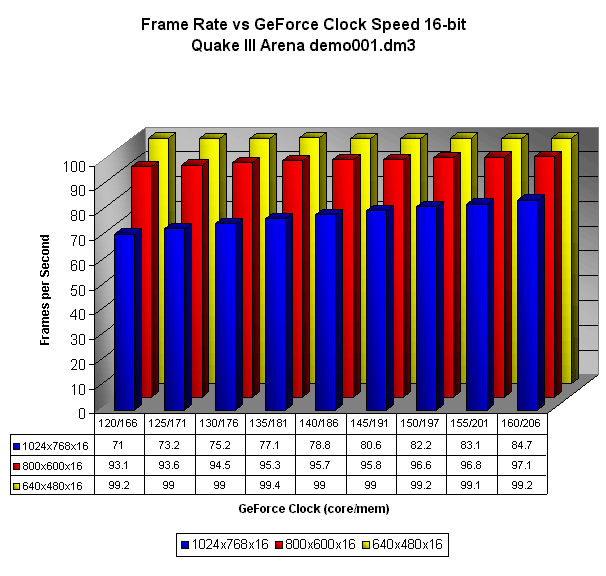NVIDIA GeForce SDR Roundup (February 00)
by Matthew Witheiler on February 16, 2000 1:32 AM EST- Posted in
- GPUs
Provided that your SDR GeForce card can reach overclocked speeds, the table below shows how much improvement you can expect to gain from overclocking. One of the reference boards tested here, the Gigabyte GA-GF2560, was used to push the clock and memory speeds higher than the stock rating of 120/166 MHz. Using PowerStrip, the clock and memory speeds were increased in 5 MHz intervals and the resulting frame rate was recorded. Below are graphs of both 16-bit and 32-bit performance evaluated with a Pentium III 550E in Quake III Arena.


As the above graphs show, increasing clock speed results in a significant improvement in FPS rating provided that the resolution is high enough to take advantage of the speed. At the low resolution of 640x480x16, overclocking the card does not result in any significant speed increase. It is not until the resolution of 640x480x32 is reached do we see a linear increasing trend in the data. In fact, the 32-bit data points really show how clock speed influences frame rate in a linear fashion, as show by the graph below.

The data is linear, meaning that a function can be fit to it and used to predict outcome for any clock and memory speed (given that both increase at the same rate). The equation that fits the data at 1024x768x32, which is y=.2935x+42.022, suggests that for every 1 MHz step you make to the clock and memory speeds, you can expect performance to increase .2935 FPS over the base rating of 42.022 FPS. This equation can also be used to estimate the performance gained by overclocking the memory and core by any constant amount. For example, if you wished to overclock the core and memory 12 MHz above the stock speed, the equation suggests that your FPS rating in Quake III Arena at 1024x768x32 would be .2935(12)+42.022, which evaluates to 45.5 FPS. For reference, equations for the other resolutions are listed below. These may be used as a rough estimate, but keep in mind that not all cards are going to perform exactly the same unless the testbed system is mirrored exactly.
|
Resolution |
Equation |
|
640 x 480 x 16 |
N/A |
|
640 x 480 x 32 |
y = 0.140x + 90.36 |
|
800 x 600 x 16 |
y = 0.101x + 93.3689 |
|
800 x 600 x 32 |
y = 0.33068x + 68.82 |
|
1024 x 768 x 16 |
y = 0.34x + 71.633 |
|
1024 x 768 x 32 |
y = 0.2935x + 42.022 |
The performance increase is most prevalent at 800x600x32, as this is the speed where the increased frequency pays off. With a fill rate of 640 Million Pixels per second at the highest speed we could overclock to (160/206 MHz), the resulting speed increase is a large 52%, coming at 800x600x32. At 1024x768, a 28% increase in speed is found at 32 bit color. Over the long run, it seems that performance is helped most by increasing the clock speeds at 1024x768x16, for this is where the slope of the line is greatest. The difference is least noticeable at 640x480x32, where a 6% performance gain is to be had.
If there is one thing to keep in mind it is the fact that it is not typical of a GeForce card to reach the high marks that we found with the Gigabyte GA-GF2560. In fact, at 160/206 MHz stability was compromised and the card crashed in an extensive loop. It is quite likely that your mileage will also vary. With this in mind, performance gains are likely through overclocking, as long as it is performed with a careful hand.
Now lets take
a look at the contenders, see how they perform, how far they can overclock,
the drivers used, and the pros and cons of each card.










0 Comments
View All Comments